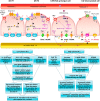Potassium Homeostasis: The Knowns, the Unknowns, and the Health Benefits
- PMID: 28202621
- PMCID: PMC5337831
- DOI: 10.1152/physiol.00022.2016
Potassium Homeostasis: The Knowns, the Unknowns, and the Health Benefits
Abstract
Potassium homeostasis has a very high priority because of its importance for membrane potential. Although extracellular K+ is only 2% of total body K+, our physiology was evolutionarily tuned for a high-K+, low-Na+ diet. We review how multiple systems interface to accomplish fine K+ balance and the consequences for health and disease.
©2017 Int. Union Physiol. Sci./Am. Physiol. Soc.
Conflict of interest statement
No conflicts of interest, financial or otherwise, are declared by the author(s).
Figures




References
-
- Adrogue HJ, Madias NE. The impact of sodium and potassium on hypertension risk. Semin Nephrol 34: 257–272, 2014. - PubMed
-
- Adrogue HJ, Madias NE. Sodium and potassium in the pathogenesis of hypertension. N Engl J Med 356: 1966–1978, 2007. - PubMed
-
- Agarwal R, Afzalpurkar R, Fordtran JS. Pathophysiology of potassium absorption and secretion by the human intestine. Gastroenterology 107: 548–571, 1994. - PubMed
-
- Appel LJ, Brands MW, Daniels SR, Karanja N, Elmer PJ, Sacks FM. Dietary approaches to prevent and treat hypertension: a scientific statement from the American Heart Association. Hypertension 47: 296–308, 2006. - PubMed
Publication types
MeSH terms
Substances
Grants and funding
LinkOut - more resources
Full Text Sources
Other Literature Sources
Medical

